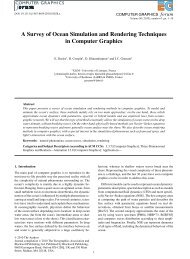Mary
Values and Beliefs_Part III
Values and Beliefs_Part III
- No tags were found...
Create successful ePaper yourself
Turn your PDF publications into a flip-book with our unique Google optimized e-Paper software.
Figure 1. A Statement of Basic Philosophy, Principle and Policy (p. 159) 19<br />
Occupational therapy is particularly concerned with man and his ability to meet the<br />
demands of his environment. The therapist administers treatment to the patient<br />
designed to (1) evaluate and increase his physical function in relation to activities<br />
of daily living, the needs of his family, and the requirements of his job, (2) improve<br />
his self-understanding and psychosocial function as a total human being. Treatment<br />
involves the scientific use of activity procedures and/or controlled social relationships<br />
to meet the specific needs of the individual patient.<br />
Figure 2. Statement of Policy (p. 24) 20<br />
1. Maintain and control the voluntary registration of its practitioners.<br />
2. Regulate, in conjunction with the Council on Medical Education and hospitals of the<br />
American Medical Association, the education of occupational therapists to prepare<br />
them for their treatment function.<br />
3. Establish and maintain standards of clinical practice in occupational therapy which<br />
will improve patient treatment.<br />
4. Foster continuing growth in the professional competence of occupational therapists.<br />
5. Encourage and facilitate increase in the body of specific occupational therapy knowledge<br />
available to physicians.<br />
6. Protect the standards of occupational therapy and the environment in which the<br />
occupational therapist functions.<br />
7. Strongly oppose and protest any administrative policy or structure which ignores or<br />
weakens the treatment function of occupational therapy.<br />
1969. These categories will not follow<br />
the previous theme format. Rather, the<br />
topics represent a sampling of concerns<br />
addressed either by the American<br />
Occupational Therapy Association<br />
(AOTA) Board of Management, or concerns<br />
external to the Association that<br />
shaped occupational therapy practice,<br />
education, or both.<br />
The Greater Profession<br />
Defining Occupational Therapy<br />
In 1969, for the first time, AOTA<br />
adopted the following formal definition<br />
of occupational therapy: “Occupational<br />
Therapy is the art and science<br />
of directing man’s response to selected<br />
activity to promote and maintain<br />
health, to prevent disability, to evaluate<br />
behavior and to treat or train patients<br />
with physical or psychosocial dysfunction”<br />
(p. 185). 17 This official definition<br />
replaced the commonly used definition<br />
that Pattison had developed in<br />
1922 18 and expanded the description<br />
conveyed in AOTA’s 1963 A Statement<br />
of Basic Philosophy, Principle and<br />
Policy 19 (see Figure 1). This definition,<br />
along with AOTA’s 1958 definitions<br />
of function 14 and 1961 Statement of<br />
Policy 20 (see Figure 2), outlined the<br />
thought and direction of the occupational<br />
therapy profession and AOTA<br />
during the 1960s.<br />
Responses From the Association<br />
In response to changes in the profession<br />
during this time, the Association<br />
provided more direction and published<br />
more books. Of special interest are<br />
the previously mentioned documents<br />
Statement of Policy, 20 and A Statement<br />
of Basic Philosophy, Principle<br />
and Policy, 19 along with two manuals:<br />
The Objectives and Functions of<br />
Occupational Therapy 14 and Occupational<br />
Therapy Reference Manual<br />
for Physicians. 21 The two statements<br />
provided a description of the role of<br />
the Association and of occupational<br />
therapy. The two manuals outlined and<br />
detailed the services provided. The<br />
manuals and statements have been<br />
used as references in the preparation of<br />
this article. Perhaps of greatest value to<br />
the profession was the role of the Association<br />
in providing publications that<br />
were written by occupational therapists<br />
instead of relying on external publishing<br />
sources and physicians to advance<br />
the knowledge base and profession of<br />
occupational therapy.<br />
Eleanor Clarke Slagle Lectureship<br />
and Award of Merit<br />
To recognize the value of professional<br />
contributions, the Association<br />
established the Eleanor Clarke Slagle<br />
lectureship in 1953. 22 The “honorary<br />
occupational therapy guest lectureship”<br />
was to be awarded “in recognition<br />
of meritorious service to the profession”<br />
(p. 24). 22 “It perpetuates the<br />
memory of Mrs. Eleanor Clarke Slagle,<br />
one of the outstanding pioneers in<br />
the field (profession) of occupational<br />
therapy. The award is bestowed upon<br />
practicing therapists who are members<br />
of the AOTA and who have made or are<br />
making a significant contribution to the<br />
profession” (p. 24). 21 Since its inception,<br />
the Slagle lectureship has been<br />
given to 44 individuals. The Award of<br />
Merit had already been established in<br />
1950 to recognize distinguished service<br />
to the profession. 23<br />
Changes in Practice Areas<br />
Practice areas were also changing relative<br />
to advances in technology, medicine,<br />
and pharmacology. Occupational<br />
therapists had worked with clients who<br />
had tuberculosis from the start of the<br />
profession, but sanatoriums treating<br />
tuberculosis were closing as drug<br />
therapy permitted outpatient care. The<br />
literature reflects the diminished practice<br />
area of tuberculosis, with the last<br />
article on this topic appearing in the<br />
American Journal of Occupational<br />
Therapy (AJOT) in 1960. 24 Similarly,<br />
the polio vaccination decreased rapidly<br />
the number of new cases of poliomyelitis<br />
in children and adults, and the last<br />
article on polio in AJOT appeared in<br />
1957. 25 Curiously, vocational rehabilitation<br />
grants were still funding postprofessional<br />
education for occupational<br />
therapists in the areas of tuberculosis<br />
and polio, which kept them in both<br />
practice areas despite fewer patients. 26<br />
During this time, as occupational<br />
therapists became more sophisticated<br />
18 DECEMBER 24, 2007 • WWW.AOTA.ORG









